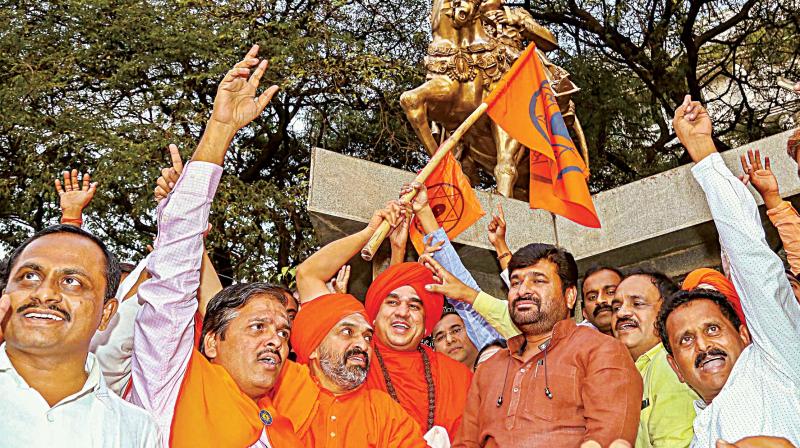Lingayat move may backfire for Congress

Far from winning over Lingayat votes for his party in the state assembly election, Karnataka Chief Minister Siddaramaiah’s recent move to propose separate religious minority status to the Lingayat-Veerashaiva community could well end up boomeranging on him and the Congress.
Even as a majority of Karnataka’s Lingayats support the decision in principle, they seem to be in no mood to reward the ruling party for it by casting their votes in its favour. A pre-poll survey conducted by JAIN and Lokniti in the state has found that although over three in every five Lingayats support the idea of granting the minority religion tag to their community, barely one in four are planning to vote for the Congress. What’s even worse for the Congress is that this current support for the party among Lingayats is three percentage points less than what was recorded by a Lokniti survey during the 2013 assembly election. This implies that instead of adding Lingayat votes to the Congress’s kitty, the separate religion status move seems to have resulted in turning some of them away from it. The pre-poll survey finds that the Lingayat voters, continue to be solidly behind their traditional voting choice, the Bharatiya Janata Party. Three in every five said they will vote for the BJP. If this level of suppo
rt persists right up to voting day- about three weeks from now, then it would not only be an improvement compared to the 2013 assembly elections, it would also nearly equal the BJP’s record performance among Lingayats in the 2014 Lok Sabha election
In the pre-poll survey, about 14 percent of all Lingayat respondents spontaneously reported Lingayatism (and not Hinduism) as their religion. Given that move by the Chief Minister, one would have expected such voters to be far more likely to vote for the Congress as compared to other Lingayats. Paradoxically,, the survey finds the exact opposite. Lingayats who reported Lingayatism as their religion in the survey were found to be three percentage points less likely to vote for the ruling party than Lingayats who reported Hinduism as their religion (21% as opposed to 24%).
A similar counter-intuitive pattern can also been seen when we look at the voting preference of Lingayats who support the move to make Lingayats a separate religion vis-à-vis those who oppose it. The BJP, surprisingly, is getting far more support among those who are in favour of the Congress government’s decision than those who are opposed to it (63% to 57%). This clearly shows that while the issue of getting an independent religion status may well be important for Lingayats, it is not being viewed as electorally significant that will determine their voting choices.
Much of the print and online media commentary in the run up to and soon after Chief Minister Siddaramaiah’s decision to propose a separate religion for Lingayats has focused on the Ishta-Linga versus Shiva-Linga division within the Lingayats arguing that a sizeable section among Lingayats who follow the teachings of Basavanna have rejected the phallic linga symbol of Shiva and opted for Ishta Linga (a symbolic representation of aformless god to be worn on the body). The pre-poll survey however finds little evidence of this. Merely one in every ten of the Lingayat respondents reported being ‘only Ishta-Linga’ worshippers. A little over half said they were exclusively Shiva-Linga worshippers and close to three in every ten said that they believed in both the Ishta Linga and the Shiva Linga. Moreover, even though the survey finds the Congress to be doing fairly well among Ishta Linga followers (getting 35% of their support), it is not enough to make up for its poor performance among the much larger community of
Shiva Linga followers and mixed followers.
Not only is the Congress unable to win Lingayat support, the other dominant OBC community in the state, the Vokkaligas, are not showing much inclination towards it either. The survey finds only 24 percent (one in four) of the Vokkaligas opting for the Congress over other parties at the moment. This is three points less than the support for the Congress in the previous assembly election. For a plurality of Vokkaligas, the Janata Dal Secular (JDS) continues to be the number one voting choice. A little less than half of them (46%) are planning to vote for the JDS in the coming election. This current support level for the JDS among Vokkaligas is in fact greater than in the 2013 election when two in every five had voted for the party. The BJP too seems to be making gains with the party presently netting 27 percent Vokkaliga votes as opposed to 20 percent last time around.
Despite its poor showing among Lingayats and Vokkaligas, the survey finds the Congress to be currently slightly ahead of its nearest competitor, the BJP, in overall terms, and this is largely due to the support it is receiving among its traditional voting bloc of backward classes, Dalits and minorities or AHINDA as it is known. According to the survey, the Congress is presently securing about three-fourths of the Kuruba vote (the community to which Siddaramaiah belongs), three-fifths of the Muslim vote, nearly half of the Dalit vote (who are about 17 percent of the total electorate) and two-fifths of the tribal vote. But here too the incumbent party has reasons to worry since the survey finds a ‘united’ BJP to have also made gains among nearly all these communities compared to the last assembly election. Having failed in its bid to encroach upon the Lingayat voter base of the BJP, the challenge before the Congress in the days ahead is to somehow stall a creeping advance of the BJP into its own territory.
(Shreyas Sardesai is a Research Associate at Lokniti)

